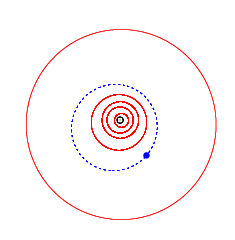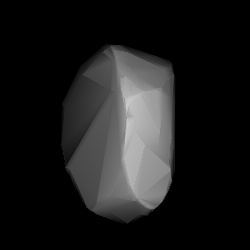Related Research Articles
Athalia, provisional designation 1903 ME, is a carbonaceous Themistian asteroid from the outer regions of the asteroid belt, approximately 40 kilometers in diameter. It was discovered on 20 September 1903, by German astronomer Max Wolf at the Heidelberg Observatory in southwest Germany. The asteroid was named after the ancient Judahite queen Athaliah.
827 Wolfiana, provisional designation 1916 ZW, is a Florian asteroid from the inner regions of the asteroid belt, approximately 8 kilometers in diameter. It was discovered at Vienna Observatory on 29 August 1916, by Austrian astronomer Johann Palisa, who named it after German astronomer Max Wolf. The assumed stony asteroid has a rotation period of 4.0654 hours.
1026 Ingrid, provisional designation 1923 NY, is a stony Florian asteroid and long-lost minor planet (1923–1986) from the inner regions of the asteroid belt, approximately 7 kilometers in diameter. It was discovered by Karl Reinmuth at Heidelberg in 1923, and later named after Ingrid, niece and godchild of astronomer Albrecht Kahrstedt.

1050 Meta, provisional designation 1925 RC, is a stony Eunomia asteroid from the central regions of the asteroid belt, approximately 10 kilometers in diameter. It was discovered on 14 September 1925, by German astronomer Karl Reinmuth at the Heidelberg Observatory in southwest Germany. The meaning of the asteroids's name is unknown. The presumably S-type asteroid has a rotation period of 6.14 hours and possibly an elongated shape.

1132 Hollandia, provisional designation 1929 RB1, is a stony asteroid from the middle region of the asteroid belt, approximately 27 kilometers in diameter. It was discovered on 13 September 1929, by Dutch astronomer Hendrik van Gent at Leiden Southern Station, annex to the Johannesburg Observatory in South Africa. It was named for the region Holland in the Netherlands.

(9948) 1990 QB2 (provisional designation 1990 QB2) is a stony Nysian asteroid from the inner region of the asteroid belt, approximately 3.4 kilometers (2.1 miles) in diameter. It was discovered on 22 August 1990, by American astronomer Henry Holt at the Palomar Observatory in California. The likely elongated S-type asteroid has a rotation period of 3.53 hours. This asteroid has not been named.
1581 Abanderada, provisional designation 1950 LA1, is a dark Themistian asteroid from the outer regions of the asteroid belt, approximately 35 kilometers in diameter. It was discovered on 15 June 1950, by Argentine astronomer Miguel Itzigsohn at the La Plata Astronomical Observatory in La Plata, Argentina. The asteroid was named after Eva Perón.
3724 Annenskij, provisional designation 1979 YN8, is a stony Gefionian asteroid from the central regions of the asteroid belt, approximately 14 kilometers (9 miles) in diameter. It was discovered on 23 December 1979, by Soviet astronomer Lyudmila Zhuravleva at the Crimean Astrophysical Observatory in Nauchnij, on the Crimean peninsula. The S-type asteroid has a rotation period of 3.97 hours. It was named for Russian poet Innokenty Annensky.
1184 Gaea, provisional designation 1926 RE, is an Aerian asteroid from the central regions of the asteroid belt, approximately 20 kilometers in diameter. It was discovered on 5 September 1926, by astronomer Karl Reinmuth at the Heidelberg-Königstuhl State Observatory in southwest Germany. The asteroid was named after the goddess of Earth, Gaea (Gaia), from Greek mythology.
1199 Geldonia is an Eoan asteroid from the outer regions of the asteroid belt, approximately 32 kilometers in diameter. It was discovered on 14 September 1931, by Belgian astronomer Eugène Delporte at the Royal Observatory of Belgium in Uccle. The asteroid was named after the Belgian town of Jodoigne.
1532 Inari, provisional designation 1938 SM, is a stony Eoan asteroid from the outer regions of the asteroid belt, approximately 28 kilometers in diameter. Discovered by Yrjö Väisälä at Turku Observatory in 1938, it was later named for Lake Inari in northern Finland.
1384 Kniertje, provisional designation 1934 RX, is a dark Adeonian asteroid from the central regions of the asteroid belt, approximately 26 kilometers in diameter. It was discovered on 9 September 1934, by Dutch astronomer Hendrik van Gent at the Union Observatory in Johannesburg, South Africa. The asteroid was named after a character in the Dutch play Op Hoop van Zegen by Herman Heijermans.
2726 Kotelnikov, provisional designation 1979 SE9, is a stony Koronian asteroid from the outer regions of the asteroid belt, approximately 10 kilometers (6.2 miles) in diameter. It was discovered on 22 September 1979, by Soviet astronomer Nikolai Chernykh at the Crimean Astrophysical Observatory in Nauchnij on the Crimean peninsula. The S-type asteroid has a rotation period of 4.91 hours and is a suspected binary system. The asteroid was named for Soviet scientist and pioneer in radar astronomy, Vladimir Kotelnikov.
2004 Lexell, provisional designation 1973 SV2, is a stony Florian asteroid from the inner regions of the asteroid belt, approximately 7.5 kilometers in diameter. The asteroid was discovered on 22 September 1973, by Soviet astronomer Nikolai Chernykh at the Crimean Astrophysical Observatory in Nauchnij, on the Crimean peninsula, and later named for Swedish-Russian astronomer and mathematician Anders Johan Lexell.
3322 Lidiya, provisional designation 1975 XY1, is a stony Phocaea asteroid and potentially slow rotator from the inner regions of the asteroid belt, approximately 7 kilometers in diameter. It was discovered on 1 December 1975, by Soviet astronomer Tamara Smirnova at the Crimean Astrophysical Observatory in Nauchnij, on the Crimean peninsula. The asteroid was named after Russian aviator Lidiya Zvereva.
2308 Schilt, provisional designation 1967 JM, is a stony Eunomia asteroid from the asteroid belt, approximately 17 kilometers in diameter. It was discovered on 6 May 1967, by Argentine astronomer Carlos Cesco together with American astronomer Arnold Klemola at the Yale–Columbia Southern Station at Leoncito Astronomical Complex in Argentina.

2111 Tselina is a stony Eos asteroid from the outer regions of the asteroid belt. It was discovered on 13 June 1969, by Soviet astronomer Tamara Smirnova at Crimean Astrophysical Observatory in Nauchnij, on the Crimean peninsula. The S-type asteroid has a rotation period of 6.6 hours and measures approximately 23 kilometers in diameter. It was later named after the Soviet Virgin Lands Campaign.
2013 Tucapel, provisional designation 1971 UH4, is an eccentric Florian asteroid from the inner regions of the asteroid belt, approximately 11 kilometers in diameter. It was discovered on 22 October 1971, by the University of Chile's National Astronomical Observatory at Cerro El Roble Astronomical Station. It was named for one of the indigenous Mapuche chiefs.
5855 Yukitsuna, provisional designation 1992 UO2, is a stony Marian asteroid from the central regions of the asteroid belt, approximately 11 kilometers (7 miles) in diameter. It was discovered on 26 October 1992, by Japanese astronomers Akira Natori and Takeshi Urata at the JCPM Yakiimo Station. The likely elongated S-type asteroid has a rotation period of 19 hours. It was named for Minamoto no Yukitsuna, a Japanese general during the Heian era.
23327 Luchernandez (provisional designation 2001 BE31) is a Florian asteroid from the inner regions of the asteroid belt, approximately 2 kilometers in diameter. It was discovered on 20 January 2001, by astronomers of the LINEAR program at the Lincoln Laboratory's Experimental Test Site near Socorro, New Mexico, United States. The asteroid was named for ISEF awardee Lucero Hernandez.
References
- 1 2 3 4 5 6 "3669 Vertinskij (1982 UO7)". Minor Planet Center. Retrieved 15 May 2018.
- 1 2 3 4 5 6 "JPL Small-Body Database Browser: 3669 Vertinskij (1982 UO7)" (2017-06-03 last obs.). Jet Propulsion Laboratory. Archived from the original on 15 September 2020. Retrieved 15 May 2018.
- 1 2 "Asteroid 3669 Vertinskij". Small Bodies Data Ferret. Retrieved 15 May 2018.
- 1 2 3 4 5 6 7 8 "LCDB Data for (3669) Vertinskij". Asteroid Lightcurve Database (LCDB). Retrieved 15 May 2018.
- 1 2 3 Masiero, Joseph R.; Grav, T.; Mainzer, A. K.; Nugent, C. R.; Bauer, J. M.; Stevenson, R.; et al. (August 2014). "Main-belt Asteroids with WISE/NEOWISE: Near-infrared Albedos". The Astrophysical Journal. 791 (2): 11. arXiv: 1406.6645 . Bibcode:2014ApJ...791..121M. doi:10.1088/0004-637X/791/2/121. S2CID 119293330.
- 1 2 3 4 Mainzer, A.; Grav, T.; Masiero, J.; Hand, E.; Bauer, J.; Tholen, D.; et al. (November 2011). "NEOWISE Studies of Spectrophotometrically Classified Asteroids: Preliminary Results". The Astrophysical Journal. 741 (2): 25. arXiv: 1109.6407 . Bibcode:2011ApJ...741...90M. doi:10.1088/0004-637X/741/2/90. S2CID 35447010. (catalog)
- 1 2 Black, Sydney; Linville, Dylan; Michalik, Danielle; Wolf, Matthew; Ditteon, Richard (October 2016). "Lightcurve Analysis of Asteroids Observed at the Oakley Southern Sky Observatory: 2015 December - 2016 April". The Minor Planet Bulletin. 43 (4): 287–289. Bibcode:2016MPBu...43..287B. ISSN 1052-8091.
- ↑ Veres, Peter; Jedicke, Robert; Fitzsimmons, Alan; Denneau, Larry; Granvik, Mikael; Bolin, Bryce; et al. (November 2015). "Absolute magnitudes and slope parameters for 250,000 asteroids observed by Pan-STARRS PS1 - Preliminary results". Icarus. 261: 34–47. arXiv: 1506.00762 . Bibcode:2015Icar..261...34V. doi:10.1016/j.icarus.2015.08.007. S2CID 53493339.
- ↑ Nesvorný, D.; Broz, M.; Carruba, V. (December 2014). "Identification and Dynamical Properties of Asteroid Families". Asteroids IV. pp. 297–321. arXiv: 1502.01628 . Bibcode:2015aste.book..297N. doi:10.2458/azu_uapress_9780816532131-ch016. ISBN 9780816532131. S2CID 119280014.
- ↑ "MPC/MPO/MPS Archive". Minor Planet Center. Retrieved 15 May 2018.